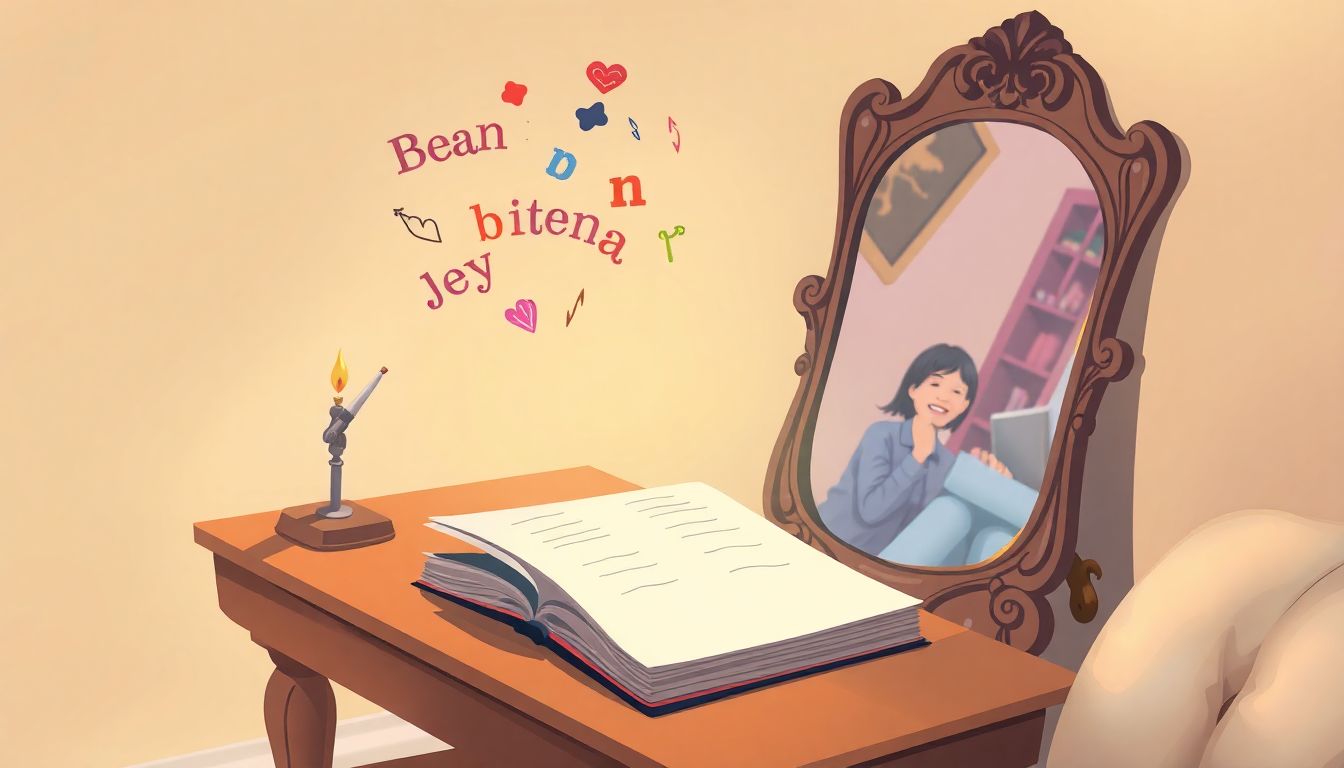Metafiction can feel a bit like staring into a funhouse mirror—exciting but also a little disorienting. If you’ve ever struggled with how to blend narrative and self-awareness in your writing, you’re definitely not alone. Many writers find it challenging to balance creativity with the playful intricacies of metafiction.
But don’t fret! If you stick with me, you’ll discover some fantastic prompts that can help unlock your creativity and enhance your stories. These prompts will inspire you to play with structure, character, and dialogue in ways you might never have considered before.
From character development to genre blending, we’ll explore a variety of interesting ideas that will have you crafting witty, self-referential narratives in no time. Let’s dive in and make metafiction fun and approachable!
Key Takeaways
- Metafiction blends storytelling and self-awareness, making it a unique writing style.
- Use prompts to spark creativity and explore meta-ideas in character, dialogue, and plot.
- Incorporate self-referential elements to deepen reader engagement and commentary on storytelling.
- Experiment with diverse structures and settings to enhance your metafiction narratives.
- Characters can grapple with their fictional existence, adding complexity and depth to stories.

Top Metafiction Writing Prompts to Spark Your Creativity
If you’re looking for a way to jumpstart your writing, metafiction can be a fun avenue to explore.
Here are some creative metafiction prompts you can use with ChatGPT:
- Create a story where the characters realize they are part of a story. Prompt: “Write a short story about characters who understand they are fictional and react to this discovery.”
- Imagine a book that describes its writing process. Prompt: “Develop a narrative where the book itself highlights how it was written, including the author’s struggles and triumphs.”
- Write a scene that breaks the fourth wall, where characters address the readers directly. Prompt: “Describe a scene where the protagonist suddenly acknowledges the reader’s presence and discusses their role in the story.”
- Design a plot twist where a character reads their own story. Prompt: “Create a plot twist that occurs when a character finds a book about their life—written by an unknown author.”
Understanding Metafiction: What It Is and Why It Matters
Metafiction is self-referential and goes beyond traditional storytelling by making the reader aware of the narrative’s fictionality.
This genre plays with the conventions of literary forms and techniques, often leaving readers questioning the nature of reality and fiction.
The importance of metafiction lies in its ability to examine narratives and storytelling itself, reflecting on the processes and purposes behind fiction.
For example, classic works like “If on a winter’s night a traveler” by Italo Calvino invite readers to engage with the material in a unique way.
Understanding metafiction enhances our appreciation for literature and encourages deeper analytical thinking about storytelling.
How to Use Metafictional Elements in Your Writing
Incorporating metafictional elements can add layers of complexity to your writing and engage readers in a fresh way.
Here are some actionable steps to add metafiction to your narrative:
- Start with a self-aware narrator. This narrator can comment on the plot or the act of storytelling itself, creating a unique dynamic.
- Use footnotes or annotations within your text. This technique allows you to provide commentary, explanations, or even jokes without interrupting the flow of the story.
- Create a story that interacts with other texts. For example, have your characters reference or debate the events of a classic novel.
- Incorporate explicit context about writing or storytelling challenges. Let your characters face the difficulties that writers encounter, almost as if they’re collaborating with the author.
Prompts for Character Development in Metafiction
Characters in metafiction often grapple with their identities and roles as fictional beings.
Use these prompts to develop complex metafictional characters:
- Design a character who wishes to break free from the constraints of their narrative. Prompt: “Outline a character who resents their storyline and seeks to change the course of their life in the book.”
- Develop a character who is aware of being a sidekick. Prompt: “Write about a side character who understands their role and wants to become the main focus of the story.”
- Create characters with conflicting realizations about their existence. Prompt: “Illustrate a clash between two characters—one who embraces their fictional nature and another who wants to escape it.”
- Explore a character with multiple identities. Prompt: “Craft a character who switches narratives or identities depending on the expectations of their readers.”

Setting the Scene: Metafictional Settings Prompts
Creating a vivid setting is crucial in metafiction, as it can reflect the themes of self-awareness and narrative exploration.
Here are some prompts to help you craft unique metafictional settings:
- Imagine a library where books can communicate with each other. Prompt: “Describe a scene inside a library where books discuss their plots and characters, revealing insights into their own stories.”
- Create a world where characters frequently step out of their own reality to critique their existence. Prompt: “Outline a setting in which characters have the ability to leave their narrative and enter a ‘behind-the-scenes’ area where they discuss their creator.”
- Design a unique universe that changes based on genre conventions. Prompt: “Write about a place where the setting morphs according to the genre—turning from a mystical forest to a gritty cityscape based on the characters’ mood.”
- Construct a story in a setting that resembles a writer’s workshop. Prompt: “Develop a narrative that takes place in a workshop where characters take writing lessons to shape their futures.”
Dialogue Prompts for Metafictional Conversations
Dialogue in metafiction can reveal characters’ awareness of their own constructedness and lead to engaging interactions.
Try these prompts to generate thoughtful metafictional conversations:
- Write a conversation between two characters who realize they’re in different stories. Prompt: “Create a dialogue where one character attempts to convince another that they exist in a separate narrative universe.”
- Create a discussion about genre conventions between two fictional characters. Prompt: “Script a debate where characters argue about the typical tropes of their respective genres, questioning why they can’t break free.”
- Design a scene where characters directly address the author’s choices. Prompt: “Compose a dialogue where characters express their frustration or gratitude towards the author for the decisions made in their storyline.”
- Have characters discuss the concept of ‘endings’ and what comes after. Prompt: “Write a conversation involving characters pondering their own endings and whether they have any choices left to make.”
Structure Your Story: Unique Plot Prompts for Metafiction
In metafiction, the structure can play a crucial role in enhancing the narrative’s self-awareness.
Here are some plot prompts to help you explore unique storytelling methods:
- Outline a story where the plot is interrupted by its editing process. Prompt: “Create a narrative that pauses for an ‘editorial meeting’ where characters discuss plot holes and narrative arcs.”
- Design a plot that revolves around a character rewriting their own story. Prompt: “Script a storyline where the protagonist finds a typewriter and decides to alter their fate, unsure of the consequences.”
- Imagine a narrative where different characters’ viewpoints clash due to conflicting storylines. Prompt: “Construct a plot where characters from different genres meet, and their varying perspectives create chaos.”
- Develop a plot that includes a character discovering a manuscript about them. Prompt: “Outline a story where a character uncovers a manuscript that predicts their future, leading them to question their choices.”
Using Self-Reference in Metafiction: Prompts to Try
Self-reference is a hallmark of metafiction, as it highlights the act of storytelling itself.
Here are some prompts to inspire self-referential writing:
- Create a character who can pause the narrative to explain their thoughts. Prompt: “Write a scene where a character uses an imaginary remote to pause the story and explain their motivations directly to the reader.”
- Imagine a scenario where the narrator comments on the readers’ expectations. Prompt: “Develop a narrative where the narrator anticipates reader reactions and addresses them throughout the story.”
- Outline a story that includes a commentary on its own themes. Prompt: “Script a scene where a character explicitly discusses the themes of identity and fictionality within the plot.”
- Design a story that includes a chapter labeled ‘The Author Speaks.’ Prompt: “Create a chapter where the author breaks in to explain the creative process and decisions made while writing the book.”

Writing Metafiction with a Twist: Unexpected Prompt Ideas
Metafiction allows you to bend the rules of narrative in fun and surprising ways.
These unexpected prompts can shake things up, bringing fresh ideas to your writing process:
- Craft a story where the author and characters have a debate about who has more power. Prompt: “Write a scene in which the author argues with characters over plot directions, each trying to assert their authority.”
- Design a metafictional story that starts from the ending and rewinds to the beginning. Prompt: “Create a narrative that unveils its conclusion first, then explores how the characters reached that point.”
- Imagine characters from different books meeting in a shared universe. Prompt: “Outline a tale of characters from diverse genres interacting and confronting their stereotypes.”
- Write a scene where a character suddenly becomes part of a different genre. Prompt: “Describe a story where a serious character ends up in a whimsical fairy tale world, leading to hilarious consequences.”
Combining Genres: Metafiction Prompts for Genre Blending
Genre blending in metafiction can create intriguing and unique narratives.
Here are some prompts for mixing different genres in your metafiction writing:
- Imagine a sci-fi story featuring a detective who solves mysteries in a parallel universe. Prompt: “Write about a detective who not only investigates crimes but also has to navigate through alternate realities of classic sci-fi novels.”
- Craft a romantic comedy that parodies classic literature. Prompt: “Create a love story that playfully critiques well-known romantic tropes from literature, including witty commentary from characters.”
- Develop a horror story where the protagonist discovers they’re in a movie script. Prompt: “Write a chilling narrative where a character realizes they are being stalked by a horror movie villain while they themselves are part of a script.”
- Combine fantasy and mystery by setting your story in a magical library where books hold secrets. Prompt: “Outline a plot where the protagonist solves a mystery after discovering that the stories in the library reveal hidden truths about the world.”
Sharing Your Metafiction: Tips for Publishing and Feedback
Once you’ve crafted your metafiction, it’s time to share it with others!
Consider these tips for publishing your work and gathering valuable feedback:
- Join writing workshops or communities that focus on experimental writing. Engage with fellow writers who understand the nuances of metafiction.
- Submit your work to literary magazines that appreciate innovative storytelling. Look for those that specifically mention an interest in metafiction.
- Utilize social media platforms to create a reader base. Share excerpts or metafictional commentary to spark interest around your work.
- Encourage reader feedback by framing specific questions when sharing your work. Ask them what they felt about the self-referential aspects or the genre blending.
FAQs
Metafiction is a form of writing that self-consciously addresses the devices of fiction, often blurring the lines between reality and fiction. Unlike traditional fiction, it invites readers to reflect on the act of storytelling itself.
Writers can incorporate metafictional elements by using techniques like self-reference, breaking the fourth wall, or creating characters aware they are in a story. These elements enhance depth and invite readers to engage critically with the narrative.
Prompts for metafiction can include scenarios where characters become aware of their narrative confines, stories within stories, or unconventional formats like letters or emails. These inspire creativity and challenge traditional storytelling structures.
Consider submitting your metafiction work to literary journals, online platforms, or self-publishing. Engage with writing communities for feedback and support, helping refine your work before sharing it with a broader audience.
